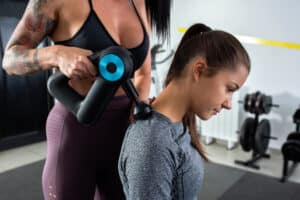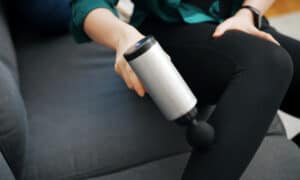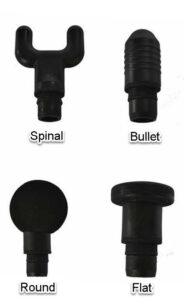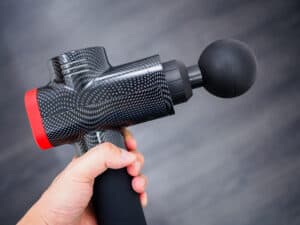Do you get sore and stiff muscles? Whether you’re a fitness enthusiast, a weekend warrior, or a sedentary office worker, a massage gun could be the answer to your problems. With an investment like this, you might never need to visit your massage therapist again! In this article, we will discuss how to use a massage gun.
How does a massage gun work?
Percussive massage is where continuous, rapid vibrations (or soft compressions) are applied to a muscle or muscle group. When these percussions penetrate the soft tissue it can help to reduce pain relief, enhance tissue repair, reduce muscle tightness (increasing mobility), and promotes relaxation.
A massage gun works almost like a mini jackhammer, delivering percussive therapy by repeatedly impacting the soft tissue at speed. Most offer a number of different customizable speeds, amplitudes (depth the massage gun “punches” into the muscle), and stall force (the amount of “force” you can apply to the massage gun against the body before the motor stalls). The repeated rapid strokes of a massage gun into the muscle can penetrate tissues deeper than can be achieved with the hands.
When should you use a massage gun?
When is the best time to use a massage gun? Many people use them before a workout, during a workout, or after a workout. Really though they can be used at any time you feel like you’d benefit from a massage.
Before a workout
 Although most people use their massage gun after a workout, there are benefits to using it beforehand. Using it prior to a workout can relax and elongate the fibers of the muscle. This can help to prevent muscle pulls and strains. Muscles are more prone to injury when rigid and stiff (that’s why we stretch before a workout) but using a massage gun can enhance the warm-up process. This doesn’t have to be a full-on massage session – just 30 seconds on each of the muscle groups you intend to work out can be beneficial.
Although most people use their massage gun after a workout, there are benefits to using it beforehand. Using it prior to a workout can relax and elongate the fibers of the muscle. This can help to prevent muscle pulls and strains. Muscles are more prone to injury when rigid and stiff (that’s why we stretch before a workout) but using a massage gun can enhance the warm-up process. This doesn’t have to be a full-on massage session – just 30 seconds on each of the muscle groups you intend to work out can be beneficial.
After a workout
This is probably the best (and most popular time) to use a massage gun. After a tough workout, spend a minute or two on each of the muscle groups you’ve worked. If you’re new to percussive therapy start slow with a lower setting and just rest the massager on the area to be treated. After a while, you’ll probably want to work up to higher speeds and really press that massager deep into the muscles. This will increase blood flow, reduce aches and pains, and speed up the muscle repair process.
Massage guns are for anyone, any time
You don’t have to be a fitness enthusiast to learn how to properly use a massage gun. Some people use them when experiencing general aches and pains or stiffness. For example, if you’re sitting in an office chair all day, many people experience a stiff neck, shoulders, and upper back (also known as “tech neck”). This can be relieved by using a massage gun at a lower speed around the back of the neck and shoulders (while avoiding the spine, bones, and front of the neck).
A massage gun is a great way to increase flexibility and mobility for anyone, you can also use a percussion massager just to promote relaxation after a hard day.

How often to use a massage gun?
Some people like to use a massage gun every day. Others use it as a warm-up and/or cool-down on workout days only. What if you’re not a fitness buff and just want to use it to improve flexibility and mobility? Just use it whenever you feel you need it. Don’t go overboard though – it’s not necessary to use it more than once a day and you only need to use it for a minute or two for each muscle group. Some people find using a foam roller after will help post-workout.
Massage gun attachments
 Most massage guns available today come with a range of different interchangeable attachments. Usually anything from 4 to 8 heads that only take a few seconds to remove and swap to a new one. Each attachment has its own function and is most useful for a specific body part or area. Here are the most common ones you can expect with your massage gun:
Most massage guns available today come with a range of different interchangeable attachments. Usually anything from 4 to 8 heads that only take a few seconds to remove and swap to a new one. Each attachment has its own function and is most useful for a specific body part or area. Here are the most common ones you can expect with your massage gun:
Spherical/Ball Head
This is the standard head that comes with all massage guns and is the most versatile of all. It’s just a round shape head, usually made from a type of hard foam. It’s good for overall, general deep tissue massage so can be used for many different areas of the body.
Spinal/U Shaped/Fork Head
This 2 pronged fork attachment is mainly used for the spinal area (either side of the spine – avoid the bone) and for the feet and ankle areas.
Bullet
This is suitable for massaging trigger points and also to pinpoint your treatment for tight areas. It is often used on the hands and feet and for the removal of muscle knots.
Flat
The flat attachment is great for shoulder blades and IT bands but can also be used for full-body massage and relaxation. It can be used on smaller surface areas and also for denser muscle groups.
There are others, but these are the main 4 that you should look out for as they will be enough to massage most areas of the body. Some people also like to use a soft attachment which can give a lighter touch to bony or tender areas of the body. Theragun is one model that includes a soft attachment.
How to use a massage gun
A handheld percussion massage gun is very straightforward to use.
- Switch on your massager (before you apply it to your body) and choose a low setting to begin.
- Rest the massager on the area you want to treat. You don’t need to push or apply pressure as the massager will do the work for you.
- Glide it slowly along the body perpendicular to the muscle. Adjust the speed settings according to what feels comfortable.
- If you come across a muscle knot or an area that needs a bit of extra treatment just rest it on that area for 1-2 minutes. Apply some pressure if necessary. Some massage guns allow you to apply more force than others before stalling (this is known as the “stall force”). This is mostly only applicable to those with dense muscle.
See our list of the best percussive therapy massagers
How NOT to use a massage gun
Be careful if you feel pain
Massage guns have both pros and cons. The most important thing to remember when using your massage gun is to listen to your body. While we often like to think “no pain – no gain” this isn’t necessarily true when it comes to a device like this. The reality is that although a massage gun can have some fantastic benefits, it’s no match for a massage therapist when it comes to knowing the difference between muscle, bone, fascia, and nerves. It doesn’t know if you’re injured. So if you’re feeling pain when using the massager, hold back and move away from that area because you could end up doing more damage than good. If you’ve got a muscle strain, sprains or inflammation it’s best to speak to a doctor or physical therapist before proceeding.
Avoid your bones and joints!
Avoid having your massager pound on bony areas (e.g. your elbow) with the harder attachments because you really will feel it. You should also avoid directly massaging the joints. Either protect the area with some padding (like a towel) or just use a soft attachment. A massage gun can be dangerous if used incorrectly.
It may seem obvious, but don’t use it around the head and face, and front of the neck (throat area).
Massage guns are safe and effective as long as they’re used as recommended. Read the manufacturer’s instructions, warnings, and contraindications before you use your massager. If you have any doubts about their suitability for a particular condition make sure to consult your doctor or physiotherapist.

